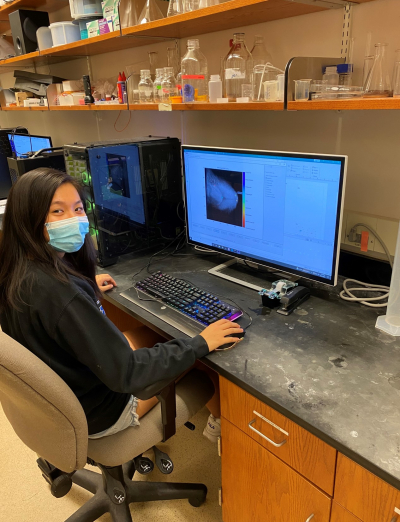Grace Lee

We expressed channelrhodopsin (ChR2) in three VGlut2-Cret+ and two PV-Cre+ mice through injection of an adeno-associated virus (AAV5-DIO-ChR2-eYFP) throughout the superior colliculus (SC). Specifically, we tracked three regions in the VGlut2-Cre+ mice: m5 (AP -1.68mm, ML -0.1 mm, DV 1.2mm), m40 (AP -1.68mm, ML -1.2mm, DV 1.6mm), and m42 (AP -1.68mm, ML +/- 0.2mm, DV 1.4mm) and one region in the PV-Cre+ mice: m59 (AP -1.68mm, ML 0.2mm, DV 1.2mm) and m66 (AP -1.68mm, ML 0.2mm, DV 1.2mm), which was confirmed by postmortem examination. By measuring direction and velocity of movement during optogenetic stimulation, we were able to find associations between regions of the SC and degree of turning, subtle movements of the head when the animal was given a limited range of head movement (semi-head-fixed), and direction of licking during head-fixed stimulation.
To quantify the turning behavior, we tracked six points: the head, right foot, left foot, chest, body, and tail base which yielded three measurements: body turn angle, neck angle, and distance traveled (mm). Body turn angle was calculated based on the angle between the chest and tail base, neck angle based on the angle between the face and chest, and distance traveled based on the difference in the animal’s starting and ending positions during stimulation. Body turn angle revealed the direction and degree of turning during forward movement, and neck angle revealed the degree to which the animal turned inward into a curled posture.
Optogenetic stimulation of different regions of the SC elicited contraversive turning movements that increased with frequency of stimulation. Unilateral excitation of the m5 region in VGlut2-Cre+ mice yielded contraversive turning, and magnitude of turning increased with stimulation frequency (Fig. 1a). Stimulation of all regions produced inward turning into a curled posture as represented by the neck angle, and the magnitude of this inward turning generally increased as stimulation frequency increased (Fig. 1b). Excitation of VGlut2-neurons in the SC produced more inward turning and less forward movement compared to excitation of PV-neurons.
We examined head movement during stimulation in a semi-head-fixed condition, where the force of head movements was tracked with load cells. Unilateral excitation of VGlut2-neurons in the m5 region caused forward movement, while unilateral excitation of VGlut2-neurons in m40 and m42 generally caused backward head movement in both hemispheres at all frequencies (5Hz, 10Hz, 20Hz, and 40Hz). Unilateral excitation of the PV-neurons in the m59 and m66 regions caused forward head movement at all frequencies (10Hz, 20Hz, 40Hz, and 80Hz).
When animals were completely head-fixed, we noticed that stimulation caused licking, though typically only during higher frequencies of stimulation. Unilateral stimulation of VGlut2-neurons in the m40 and m42 regions yielded contraversive licking for both the right and left hemispheres at 40Hz. Licking was not elicited in the m5 mice, though that could have been due to fading effectiveness of the channelrhodopsin. In the PV-neurons, unilateral stimulation of the left hemisphere elicited contraversive licking in both the m59 and m66 mice at 20Hz and 40Hz, and right hemisphere stimulation elicited contraversive licking in m66 mice at 40Hz and 80Hz.
Stimulation of the PV- and VGlut2-neurons in the SC caused contraversive turning leading to changes in orientation, posture, and eye movement. I plan to continue this work at the Yin Lab in the fall by focusing on the connections between the SC, the basal ganglia, and other midbrain structures using a Cre-dependent anterograde tracing virus (AAV-DIO-GFP) and a Cre-dependent retrograde viral tracing strategy (AAV-DIO-Retro Dre). We also plan to investigate why and how the superior colliculus elicits licking during head-fixed stimulation.